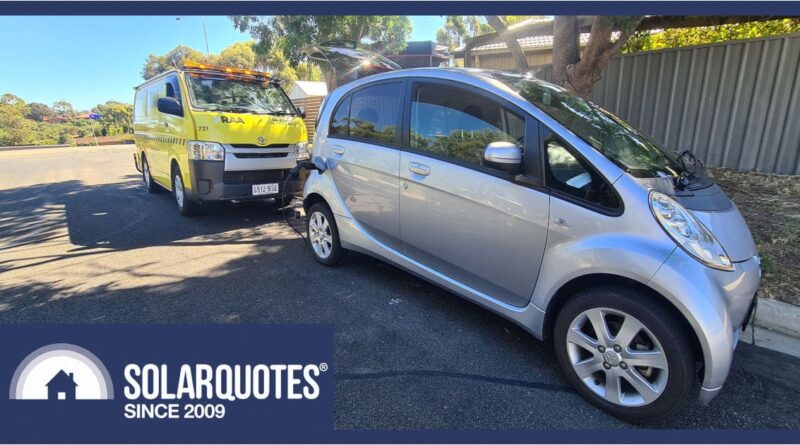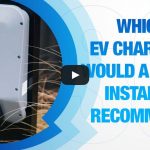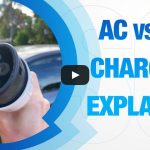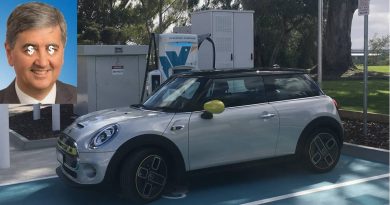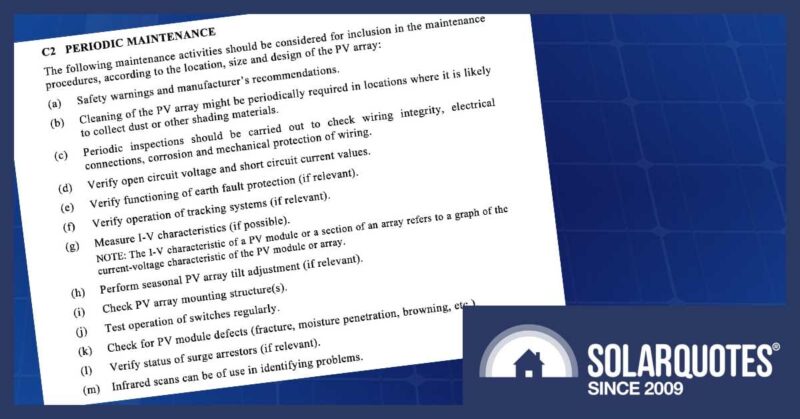Budget EV Diaries: Running on Empty and the RAA Rescue
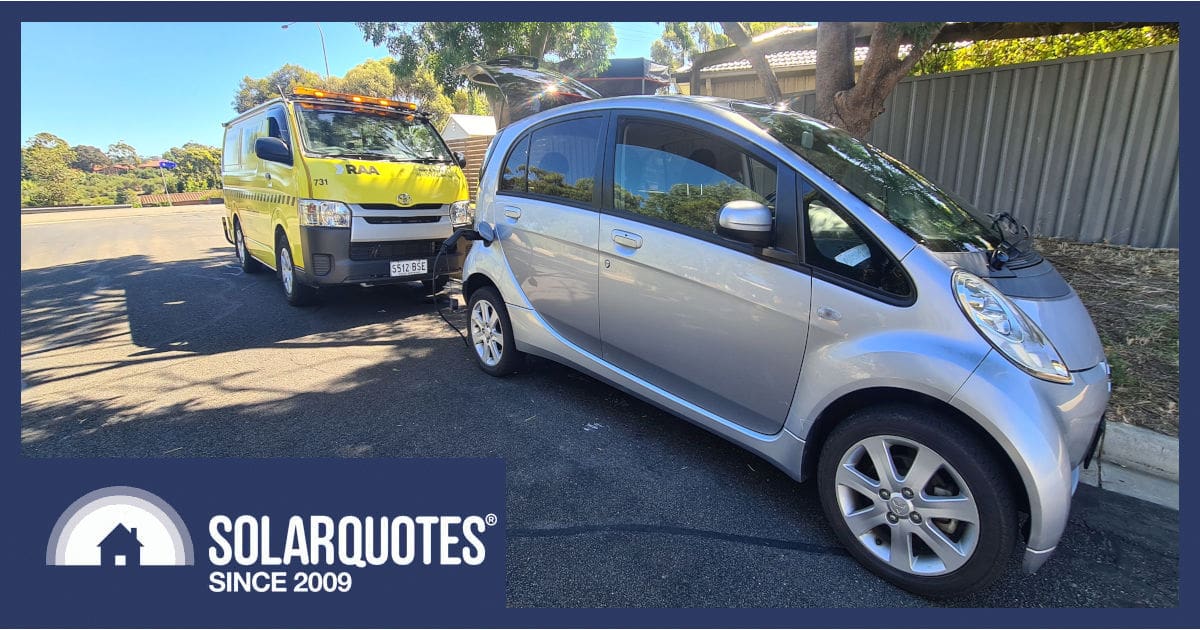
As I wrote last week, I’ve recently picked up a really cheap electric vehicle. Since then, I’ve been testing out the battery, mulling over why we feel the need to name cute cars… and trying out the RAA’s new emergency charging service for EVs. Oops.
Here’s a little insight into my journey so far as an iMiev owner, for the second time around, and what happened when things went awry.
Naming Rituals: Forming Bonds With Cars Is Normal, Right?
While I have always been a car enthusiast, I’ve never really named my cars (the exception being whatever car I happened to be racing at Mallala, which I usually called: “Whoa, Betsy”, as she squirmed under brakes, trying to wash off 100mph into a hairpin).
The iMiev is such an endearing little thing, though. My first I named Irene, and my latest purchase became Greg the Golf Ball, because of the many dents left in the roof after a hailstorm. Equally, however, he could be called ‘Alf-Price Harry.
Tesla encourages you to name your EV, and I think it’s an encouraging trend that pushes people to actually look after their cars. EVs should last a good deal longer than your average combustion engine vehicle, and caring for them is a no brainer in environmental terms.
Getting A Feel For Battery Capacity
With double the mileage in a marginally older car, it’s unsurprising that Greg’s battery isn’t as good as Irene’s. By the seat of my pants, he’s not quite as zippy and doesn’t quite recharge as much going down the hills, but the ‘Guess-O-Meter’ range prediction of 75km on the dash does track well against kilometres covered.
From 16kWh originally, the monitoring app says we’re running 75% state-of-health for Irene, so we’re down to about 12kWh — or close to a new Tesla Powerwall. In real-world terms, that has translated into an 86km journey with me driving modestly and arriving comfortably.
Greg, on the other hand, is showing 61% state-of-health, or 9.7kWh — almost bang on the modest-sized, three-module battery that Sungrow offers with its 5kW solar hybrid system for a house. With less sympathetic highway driving, (which saps performance with aerodynamic load) we made 67km, at which point I was relieved to have made my destination.
Pushing The Boundaries of Range
Despite a year’s worth of uneventful motoring with Irene, it was only the third time I drove Greg that I ran out of battery. Hooray, new achievement unlocked!
Initially, we did a couple of short runs, and on the following day I set off for the office with a little over half a battery remaining.
I took Trev the manager out for a little test ride, and as I drove home again in the traffic, I experimented with pressing the air conditioning button and watching the range indicator immediately drop by 4km. With shenanigans like that, perhaps I got what was coming to me.
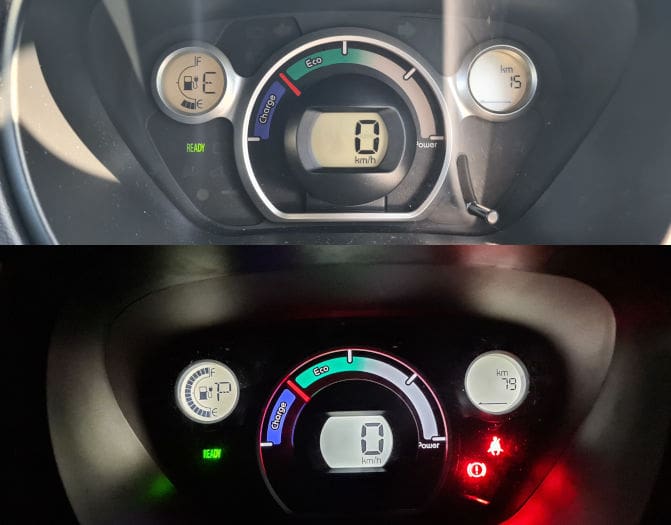
Vintage EV instrument cluster. Fuel gauge on the left, Guess-o-meter on the right. I normally set the trip meter to display distance travelled.
Gambling With The Guess-O-Meter
The Guess-O-Meter gets its (unofficial) name from stunts such as climbing Flagstaff Hill, and then finding that 138-metre ascent over 3km actually eats up 10km to 12km of predicted range.
I could have stopped for a free charge at Tonsley, but I actually wanted to get home with a near-flat battery, to run another test. So with 14km remaining, I turned up the hill and pinned the throttle open.
While my wife has commented about how zippy Irene is on this stretch, Greg responded casually, and having climbed the steep part, he got more and more… casual. Eventually, I wasn’t comfortable being on a 70km/h dual-lane road and turned into a side street.
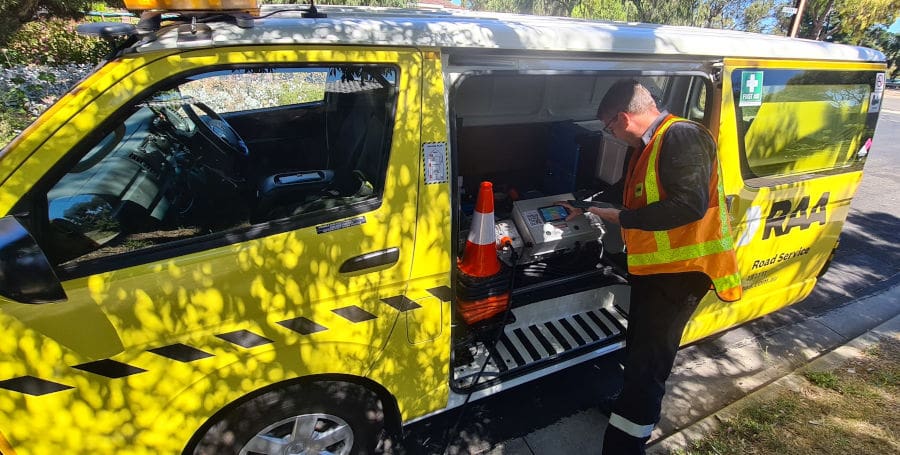
The RAA’s First EV Rescue Customer
I knew the RAA had an EV charging van, they’d been promoting it on their socials. And while I’m not 100% sure I was the first to use it, they’re not denying it.
I called them up, and after a couple of mildly embarrassed ‘umm’s and ‘ahh’s, I had a rescue planned for within the hour. A callback followed, from someone asking exactly what model I had, because an iMiev is an older EV with a type 1 charging plug — something I’m glad they were across.
Bear in mind that in the past I have made an RAA mechanic bring me a piece of wire and some gasket cement to fix a fuel pump, and cajoled the country service bloke into helping me drive a tek screw through a broken fan belt tensioner half way back from Melbourne. I wouldn’t be without them.
Nerding Out Over Hardware
When the van arrived I got to have a stickybeak at what I immediately recognised as a Victron off-grid power system. Noice.
The road service mechanic had only just done some training, but I was able to run over the finer details with him on how it all worked.
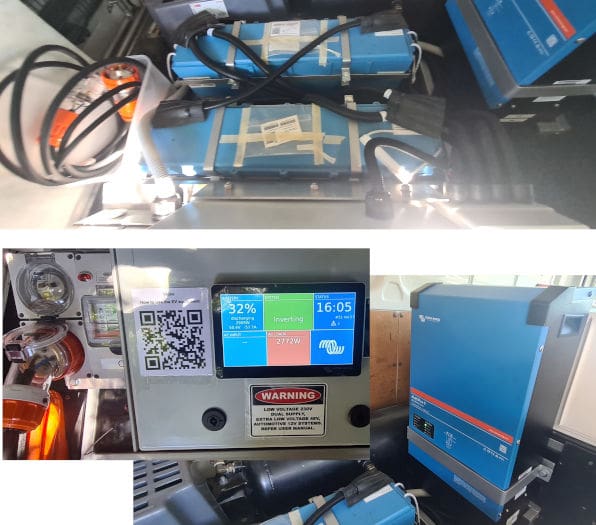
Stick your head in the side door to see two batteries in the middle, the inverter to the right and touchscreen in the centre, with input and output sockets on the left.
Basically, here’s what we had:
Two x Victron Lifepo4 25.6V 200Ah batteries:
These provide 10.2kWh nominal or 8.2kWh useable storage. Roughly speaking, that’s 50km of range in the tank — enough for the RAA to rescue three cars, they say.
One x KWIK Portable Type 2 EVSE | 32 Amp | 7kW:
With an extension cord to suit.
One x Victron Cerbo Touchscreen.
One x Victron Multiplus 48/8000 Inverter to supply the power:
While this seemed to work fine, I would have specified a better machine — at 40°C the multiplus is only rated for 5.5kW. I understand Victron has a lovely screen to display information, but there are Australia-made inverters, rated for less, that actually do more.
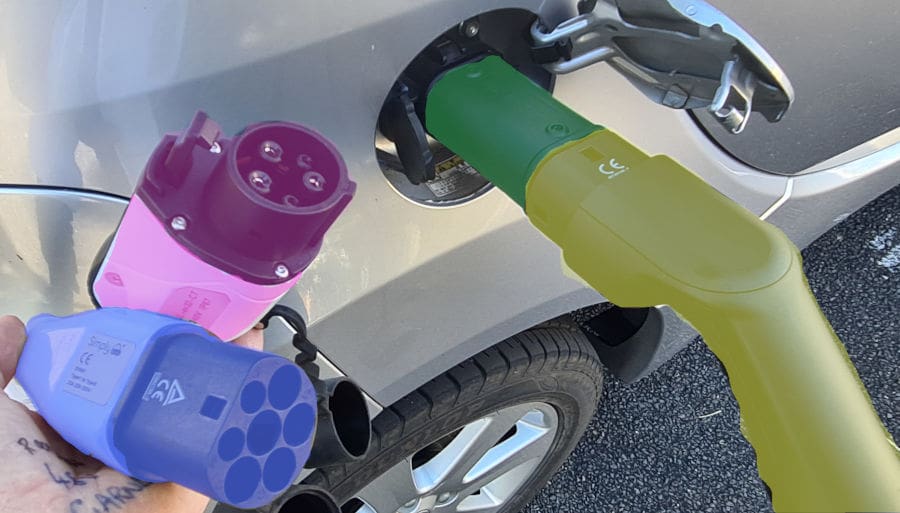
This BYO lead for public charging has a type 1 plug for older EVs (pink) and a type 2 plug for untethered charge points (blue). The yellow type 2 plug is found on a tethered charge points, so older EV owners need an adaptor (green). Sadly, this is the magic of photo editing. If only they were colour coded in real life.
Plugging Standards Almost Brought Us Unstuck
I had a cable with me that allows the car to charge at an untethered public pillar. However this cable can’t be used as an extension cord for a tethered charging station.
What I needed was an adaptor to get the tethered lead extending from the RAA van into my type 1 vehicle. Luckily there was one hiding in the van. And with that, legacy EVs are saved.
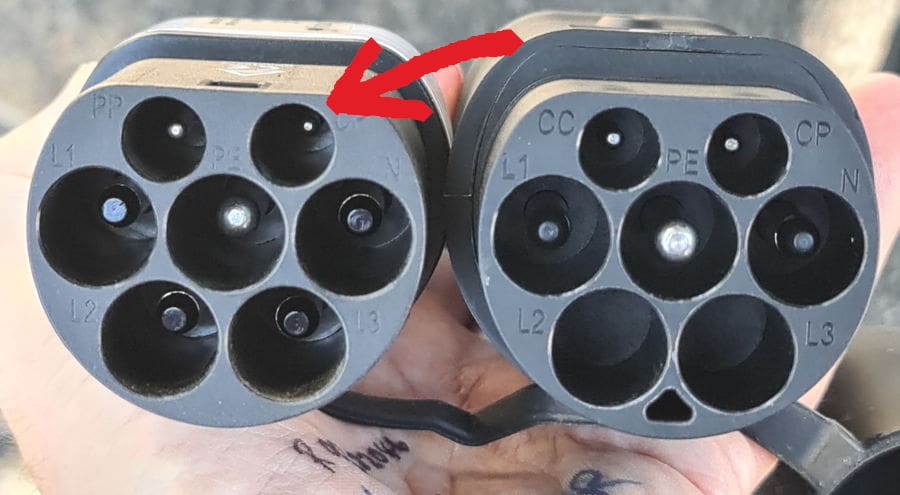
That pilot pin is just a little further recessed into the hole, so your untethered EV charging lead can’t be used as an extension cord.
Just 25 Minutes Later, We Were Back In Business
The whole process probably took a little longer than usual, because we were having a good old conversation. But after 1.23kWh donated, and with three bars on the fuel gauge, I headed home — with an RAA escort for 3km just to be sure.
Overall it was a great service; one that should bring comfort to anyone with new-EV anxiety.
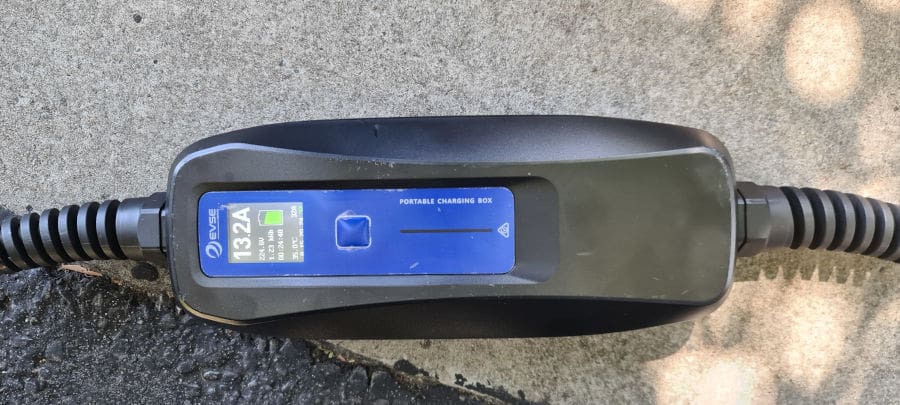
The KWIK Portable Type 2 Charger showing 13.2amps at 230VAC as Greg charges from the RAA van.
What Could Be Done Better?
Protection from the elements
A simple improvement would be investing in an awning to shield both operators and equipment from the elements.
Also, while the weather on this particular day was gorgeous, modern vehicles are designed to be air conditioned. With so much glass, the risk of overheating is real. I would pack a weighted blanket in the van to shade the windows on the stricken vehicle. As the saying goes: “dogs die in hot cars”.
Operators could also pack some drinks. If you’ve already been stranded for an hour, there might be a real need for hydration.
Solar powered rescue vehicles
On general principle, I’d suggest a kilowatt or two of solar on the van roof. Panels are easy to DC couple to the battery, making the rescue battery a self-filling jerry can.
Recharging en route
Having a DC-to-DC charger would also enable the 12volt system in the van to top up the 48v rescue battery while driving from job to job.
And having a different EV charging adaptor on hand would also allow RAA drivers to pull up and recharge the rescue battery at an ordinary EV charging station, twice as fast as plugging in back at base, without the added travel.
What Did We learn?
While this wasn’t the experiment I was planning on this particular day, it was worthwhile all the same.
I may have pushed Greg’s boundaries a little far, but I learnt how this battery behaves at a low state of charge and how it’s different to what I’ve come to expect from a healthier set of cells. Best of all, I know what to do, and how much leeway there is if we push the envelope.
All in all, I was impressed by the RAA’s service; I got first-hand experience of an EV rescue operation, and a good look at some mobile charging tech; and I got some material for a blog. As far as breakdowns go, you can’t ask for much more than that.
Original Source: https://www.solarquotes.com.au/blog/electric-vehicle-rescue-emergency-charging-service/

